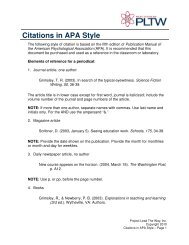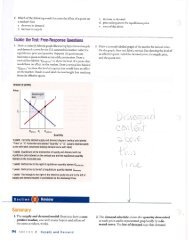AP Econ Module 30 Deficits Debt - Sunny Hills High School
AP Econ Module 30 Deficits Debt - Sunny Hills High School
AP Econ Module 30 Deficits Debt - Sunny Hills High School
Create successful ePaper yourself
Turn your PDF publications into a flip-book with our unique Google optimized e-Paper software.
What Happened to the <strong>Debt</strong> from World War ll?<br />
As you can see from Fiqure <strong>30</strong>.4, the govern- dipped slightly in the next few years, as the cause the debt-cDp ratio had ta en by more<br />
ment paid for World War ll by borrowing on a United states ran postwar budget su rpluses, but than half. The reason? Vigorous economic<br />
huge scale. By the war's end, the public debt the government budget went back into deficit in growth, plus mild inllation, had led to a rapid<br />
was more than 100% of Goq and many people 1950 with the start of the Korean War. By 1962, rise in GDp The experience was a clear lesson<br />
worried about how it could ever be paid off. the public debt was back up to $248 billlon. in the pecutiar fact that modern governments<br />
The truth is that it never was paid off, ln 1946, But by that time nobody was worried about can run deficits forever, as long as they aren't<br />
the public debt was $242 billion; that number the tiscal health ol the U.S. government be- too large.<br />
government spending. This has led to a rapid rise in the debr GDt) ratio. For this<br />
reason, some economic analysts are concerned about the long-run fiscal health of<br />
theJapanese economy.<br />
lmplicit Liabilities<br />
Looking at Figure <strong>30</strong>.4, you might be rempted ro conclude that the U.S. federal<br />
budget is in fairly decent shape: the return to budger deficits after 2001, and largebut<br />
temporary increases in government spending in response ro the recession that<br />
began in 2007, caused the debt GDP rario to rise a bit, but rhar rario is still low compared<br />
with both historical experience and some other wealrhy countries. In fact, however,<br />
experts on long-run budget issues view the situation of rhe United States (and<br />
other countries with high public debt, such as Japan and Greece) with alarm. The reason<br />
is the problem of irnplicit liabilities. Implicit liabilities are spending promises<br />
made by governments rhar are effectively a debt despite the fact rhar they are not included<br />
in the usual debt statistics.<br />
The largest implicit liabilities of the U.S. governmenr arise From rwo rransfer<br />
programs that principally benefir older Americans: Social Security and Medicare.<br />
The third-largest implicit liability, Medicaid, benefits low-income families. In each<br />
ofthese cases, the government has promised ro provide transfer payments ro future<br />
as well as current beneficiaries. So these programs represent a future debt that<br />
must be honored, even though the debt does not currently show up in rhe usual<br />
statistics. Together, these rhree programs currently accounr for almost 407o of federal<br />
spending.<br />
The implicit liabilities created by these transfer programs worry fiscal experts.<br />
Figure <strong>30</strong>.6 on the next page shows why. It shows actual spending on Social Security<br />
and on Medicare and Medicaid as percenrages of GDP from 1962 to 2008,<br />
with Congressional Budget Office projections of spending througl.r 2083. Ac,<br />
cording to these projections, spending on Social Security will rise substantially<br />
over the next few decades and spending on the rwo health care programs will<br />
soar. Why?<br />
In the case ofSocial Securitl the answer is demography. Social Securiry is a "pay-asyou-go"<br />
system: current workers pay payroll taxes that fund the benefits ofcurrent retirees.<br />
So demography-specifically, the ratio of rhe number of retirees drawing<br />
benefits to the number ofworkers paying into Social Securiry has a major impacc on<br />
Social Security's finances. There was a huge surge in the U,S. birth rate between 1946<br />
and 1964, the years of the baby boom. Baby boomers are currently of working agewhich<br />
means they are paying taxes, not collecting benefits. As the baby boomers retire,<br />
they will stop earning income that is taxed and start collecting benefits. As a result, the<br />
ratio ofretirees receiving benefits to workers paying inro tl.re Social Securiry sysreIll will<br />
rise. In 2008, there were 31 retirees receiving benefits for every 100 workers paying inro<br />
lnplicit liabilities ar€ spendinq pr0mises<br />
made by governments ihat are efiectively a<br />
debt desp te the fact that they are fot<br />
inc uded n the uslaldebt statstcs.<br />
module <strong>30</strong> Long-run lmplications of Fiscal Policy; <strong>Deficits</strong> and the Public <strong>Debt</strong> <strong>30</strong>3
















